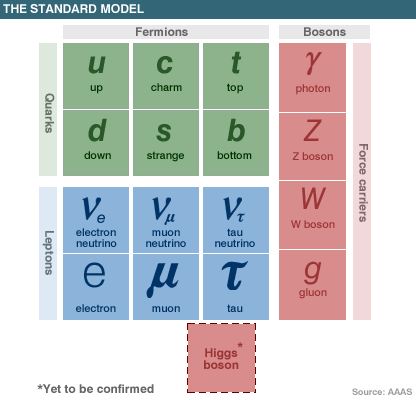Standard Model

The Standard Model is an enormously successful theory devised to explain how subatomic particles interact with each other. The Standard Model is a quantum field theory. It is effectively the union of quantum chromodynamics and the elecroweak theory. The term "Standard Model" was first used at a conference in 1974.
In the Standard Model, there are 16 fundamental particles – 12 particles of matter and 4 force carrier particles). An additional particle, known as the Higgs boson, must also be included to explain why the other 16 have mass. Particles acquire their mass, it is theorized, through interactions with an all-pervading field, called the Higgs field, which is carried by the Higgs boson.
The Standard Model was developed in the late 1960s and early '70s and has stood up to numerous experimental tests. However, it is generally accepted among physicists that it cannot be a fundamental theory of nature since it fails to include gravity, and doesn't account for the existence of dark matter, dark energy, or neutrino oscillations. Indeed, it only makes sense if viewed as a low-energy approximation.
Fundamental particle
A fundamental particle is a particle with no internal substructure. In the Standard Model, the quarks, leptons, photons, gluons, W-bosons, and Z-bosons are fundamental. All other objects are made from these particles.
Supersymmetric standard model
A supersymmetric standard model is a generalization of the standard model to incorporate supersymmetry. Supersymmetry is a symmetry principle that relates the properties of particles with a whole number amount of spin (bosons) to those with half a whole (odd) number of spin (fermions). It entails a doubling of the known elementary particle species.
Superparticles
Supersymmetry predicts the existence of superpartners of the Standard Model particles. These new types of particles, the superparticles, would represent a new quantum dimension.


